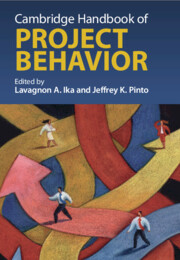Book contents
- Cambridge Handbook of Project Behavior
- Cambridge Handbook of Project Behavior
- Copyright page
- Contents
- Figures
- Tables
- Contributors
- Introduction
- Part I Guiding Principles
- Chapter 1 The Rise and Fall of the Planning Fallacy
- Chapter 2 Unveiling the Hiding Hand
- Chapter 3 Voyages of Discovery
- Chapter 4 Temporal Structuring and Project Behavior
- Chapter 5 Managing Project Complexity and Uncertainty through Dynamic and Systemic Stakeholder Modeling
- Part II Deviating from Plans
- Part III Practical Tips
- Index
- References
Chapter 4 - Temporal Structuring and Project Behavior
from Part I - Guiding Principles
Published online by Cambridge University Press: aN Invalid Date NaN
- Cambridge Handbook of Project Behavior
- Cambridge Handbook of Project Behavior
- Copyright page
- Contents
- Figures
- Tables
- Contributors
- Introduction
- Part I Guiding Principles
- Chapter 1 The Rise and Fall of the Planning Fallacy
- Chapter 2 Unveiling the Hiding Hand
- Chapter 3 Voyages of Discovery
- Chapter 4 Temporal Structuring and Project Behavior
- Chapter 5 Managing Project Complexity and Uncertainty through Dynamic and Systemic Stakeholder Modeling
- Part II Deviating from Plans
- Part III Practical Tips
- Index
- References
Summary
Project management essentially involves temporal work, in other words, the purposive effort to orient the temporal structures that guide action around given tasks. Yet, projects often involve participants or stakeholders holding different temporal orientations that may be more or less compatible with proposed temporal structures. In this paper we consider how different forms of temporal structuring influence project behavior (i.e., how participants engage with projects, and how projects play out to produce outcomes). Specifically, building on a review of the literature on projects and temporality, we explore how and why the socially constructed nature of project tasks (open-ended vs. closed-ended) interacts with efforts at temporal structuring (open vs. closed) to orient participants’ actions, with varying consequences for behaviors and outcomes. We conclude by proposing a series of future research directions aimed at better understanding the relations between temporal structuring and project behavior.
Information
- Type
- Chapter
- Information
- Cambridge Handbook of Project Behavior , pp. 71 - 83Publisher: Cambridge University PressPrint publication year: 2025
References
Accessibility standard: WCAG 2.0 A
Why this information is here
This section outlines the accessibility features of this content - including support for screen readers, full keyboard navigation and high-contrast display options. This may not be relevant for you.Accessibility Information
Content Navigation
Allows you to navigate directly to chapters, sections, or non‐text items through a linked table of contents, reducing the need for extensive scrolling.
Provides an interactive index, letting you go straight to where a term or subject appears in the text without manual searching.
Reading Order & Textual Equivalents
You will encounter all content (including footnotes, captions, etc.) in a clear, sequential flow, making it easier to follow with assistive tools like screen readers.
You get concise descriptions (for images, charts, or media clips), ensuring you do not miss crucial information when visual or audio elements are not accessible.
You get more than just short alt text: you have comprehensive text equivalents, transcripts, captions, or audio descriptions for substantial non‐text content, which is especially helpful for complex visuals or multimedia.
You can access graphs or charts in a text or tabular format, so you are not excluded if you cannot process visual displays.
Visual Accessibility
You will still understand key ideas or prompts without relying solely on colour, which is especially helpful if you have colour vision deficiencies.
You benefit from high‐contrast text, which improves legibility if you have low vision or if you are reading in less‐than‐ideal lighting conditions.
